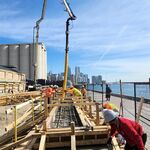Toronto has a grudge against apartments, a sentiment expressed in various ways.
A few weeks ago, a group in Parkdale held a public meeting on development in their community and invited speakers from other neighbourhoods to share knowledge on how to influence good development. The byzantine planning process is difficult to negotiate, so sharing knowledge is critical to being effective. Good design, affordability, and community amenities are all part of what people want.
The problem is the way this well-meaning group and countless other local campaigns are positioned. This particular one focused on the “900 luxury units” coming to the area. That’s an incredible way to refer to the tiny units that are most condos built in Toronto today, hardly “luxury.” Making it even more remarkable is some of the invited speakers were single-family homeowners.
So warped are perceptions in Toronto that even progressive folks consider tiny condo apartments, the first rung of the property ladder that people claw their way into, as “luxury,” but homes in the million dollar range or more are somehow not. There’s also a perception that those homeowners “contribute” to the neighbourhood and, in this case, the 900 apartment dwellers somehow wouldn’t.
To be sure, owning a house in Toronto is also a feat of economic gymnastics for many people. “The bank owns my house” is a frequently heard phrase, and the state of being “house poor” is common. It isn’t easy. But this damaging way of looking at how we live, when the single family home is valourized so passionately, ultimately means much of the city is nearly impossible to get into unless you can afford a house.
Sean Galbraith, an urban planner, shared a revealing map on social media last week that he created by pulling information from Toronto’s open data sets. Though the phrase “ugh, more condos” is a pan-Toronto rallying cry, the map shows that such things are actually allowed in relatively few parts of the city.
“I think that it reveals the problem with essentially using a 40-year-old zoning bylaw, albeit updated,” he says. “It is still a product of outmoded, decades-old ideas about separation of uses, and it rigidly enforces Official Plan policies that strongly discourage doing something different, even if compatible, in neighbourhoods.”
The map highlights the vast parts of Toronto where only single detached homes are permitted, and a smaller area where semi-detached are allowed. “I have residential clients who would like to do duplexes and triplexes, but are stymied because of zoning or development and parkland charges, making them unaffordable,” says Galbraith. “As a result, neighbourhoods with declining populations are robbed of the opportunity to have new neighbours, people who will spend money in local shops.”
Couple this with ratepayer and historic preservation groups in places where mixed-use infill is allowed but who loudly oppose not just six, eight, or 10 storey mid-rises on main streets, but nearly every attempt at gentle density inside neighbourhods. In the old City of Toronto such groups have opposed townhouses, basement apartments, lot splitting, and duplex creation. This tactic may appeal to those already in, but it alienates everybody else, especially
younger people.
Is kicking the ladder out once you’re in really the Toronto way?
The anti-apartment sentiment has sadly been strong in Toronto for a long time. The old City of Toronto long-resisted apartments, and today lacks the wealth of 1920s’ “walk ups” other cities enjoy. Streets that do have them were often in former municipalities, like Vaughan Rd. north of St. Clair Ave., in what was the old City of York, and on nearby Lonsdale Rd. that was located in the Village of Forest Hill until a 1967 amalgamation with Toronto. These are both good apartment streets, but they’re rare.
Today, amalgamated Toronto needs hundreds more of these kinds of apartment buildings, especially rental and affordable units, but the restrictions, both official and community led, result in tremendous pressure placed on the places that do permit apartment growth, like Liberty Village, where they tend to sprout up quite high.
Liberty Village is often vilified by people in single-family homes as being a “slum in the making” but it’s one of Toronto’s hero neighbourhoods, helping the city live up to its self-congratulatory “You Belong Here” motto while it whispers, “stay out.”
The stakes are high. Old Toronto missed out on building apartments when it could, now we’ve conspired to make apartment living a bad thing in much of the city. Don’t like tall buildings? Then fight for density to be spread across the city. Inclusive ratepayer and historic preservation groups that do this will be the new civic heroes.
“Everyone complains about tall towers downtown, and everyone wants mid-rise, but part of the problem is an inability to unlock additional small-scale intensification in existing neighbourhoods,” says Galbraith. “Affordable housing is always a hot-button issue, and combined with both the inability to create and resistance to infill, I think the answer is obvious: we should provide more smaller scale housing options everywhere in the city.”







